- Fantastic image quality
- Great low-light performance
- Accurate AI subject tracking
- Versatile design
- Excellent companion software
- Gets very warm after extended use
- Gesture control could be improved and expanded
After the past few years, it’s safe to say that most people have been exposed to the horrors inherent in the average webcam. Even those found in expensive, high-end laptops tend to be merely functional at best. Even upgrading to a separate, dedicated webcam really only nets you a marginal improvement.
Insta360, the company known for its portable action cams and VR cameras, has officially entered the world of webcams to offer a solution. The Insta360 Link is far more than just another 4K webcam. It’s expensive no doubt, but for those looking for the ultimate webcam setup, this little camera’s exceptional image quality and innovative gimbal stand might be what you’ve always been waiting for.
Design
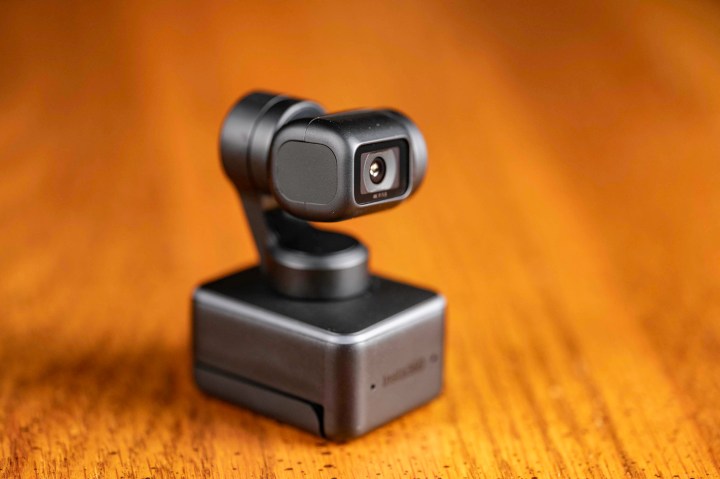
The Insta360 Link is a highly compact device, not dissimilar in form factor to many other external webcams. Its design is strikingly similar to the all-in-one camera gimbal systems which have gained niche popularity for their ability to capture smooth, cinematic footage.
The camera and gimbal stand on top of a rectangular base that features a USB-C port, touch-sensitive panel, standardized camera screw mount, and padded clip mounting system.
This mounting system is notable because it allows the Link to be easily attached to the top of just about any display. It’s remarkably secure, yet requires little effort to operate. Combined with the screw mount, it’s possible to place the Link just about anywhere you need it. I tested the Link with two separate mounting accessories provided by Insta360 — a miniature Pygtech tripod with an extending center column, as well as a prehensile arm that attaches via a clamp to tables and desks.
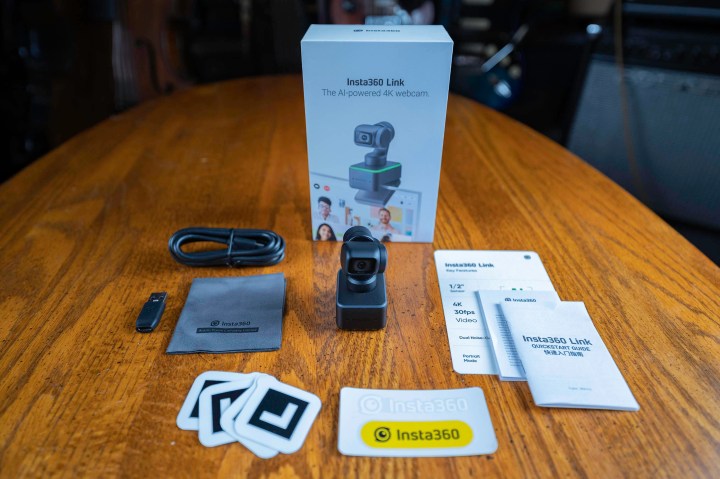
In terms of build quality, the Link is well made and fairly tough. It’s a device that seems built to last. I would, however, prefer that it come bundled with some sort of carrying case, as it’s a little awkward to transport due to the moveable gimbal design.
Image quality
Typical webcams are about the most dreary, boring devices you can possibly imagine. Built-in webcams are awful, offering abysmal image quality in good light, and nearly unusable mush in dimly lit interiors. Alternatively, you could set up a camera, such as the Nikon Z6, as a webcam for extremely high video quality, but the tradeoff is a bulky, awkward, and expensive setup.
That’s what makes the Insta360 Link just so good. The Link offers a high degree of image quality in a lightweight, convenient form factor. Also, thanks to its integrated AI and motorized gimbal, it potentially overcomes the limitations of a static camera.
It’s really impressive just how good the photos and videos from the Link look.
Capable of 4K 30fps (frames per second) video, the Insta360 Link is already way beyond the typical webcam just in terms of resolution, especially if we’re talking about the integrated webcams in laptops. There’s certainly a solid selection of 4K webcams out there, such as the Logitech Brio, the Dell UltraSharp Webcam, or the Lumina 4K.
But we all know resolution is just a number. What’s really impressive is just how good the photos and video it captures look.

Details are sharp, color is great, and it even delivers some amount of decent-looking bokeh. Even in low light, the camera performs shockingly well, and it genuinely blows any other webcam I’ve ever used out of the water.
This is thanks in part to the relatively large ½-inch sensor, which is far larger than the average webcam sensor, or even the sensors in many smartphones and compact cameras.
If it wasn’t tethered via USB-C, the Insta360 Link would be an above-average option for general photography and videography. HDR is also available, which is particularly useful in high contrast situations.
Performance
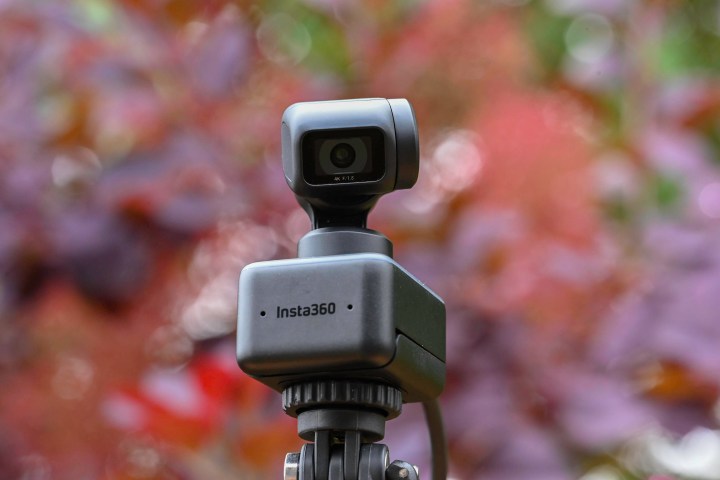
The three available gesture controls allow you to control the camera without ever having to step out of frame. The gestures available include holding up your flat palm to start and stop tracking, making a V shape with your fingers to enter whiteboard mode, and pointing upward with your thumb out to the side, then raising your hand up and down to digitally zoom in and out.
The first two gestures work fine, but the zoom control suffers from unreliable detection. With practice, I was able to learn to get it to work more reliably; you need to hold your palm very flat toward the camera and position your fingers just right while maintaining a wide distance between you and the camera. I do wish there were some additional gesture controls to expand the possibilities of the camera even further, but perhaps that’s something that could come in the future.
Subject tracking is remarkably effective, as is the autofocus system.
Of course, the gimbal allows allows the camera to follow you around the room. This isn’t the first time we’ve seen a webcam mounted to an AI-powered gimbal. Subject tracking is remarkably effective, as is the autofocus system, and the camera was able to consistently track me as I moved around a room. Whiteboard mode tracks four included stickers, and isolates the area within those stickers, correcting the image so that it’s flat and square and the whiteboard fills the frame.
For example, if you’re teaching a class you can have the camera filming you at a wide angle next to the board, and by making the appropriate gesture it will switch to whiteboard mode and zoom in on the predefined area. This makes the Link a perfect tool for teaching online classes or for making business presentations.
It should be mentioned that cameras like the Obsbot Tiny do something quite similar, though its image quality is nowhere near what the Link can do.
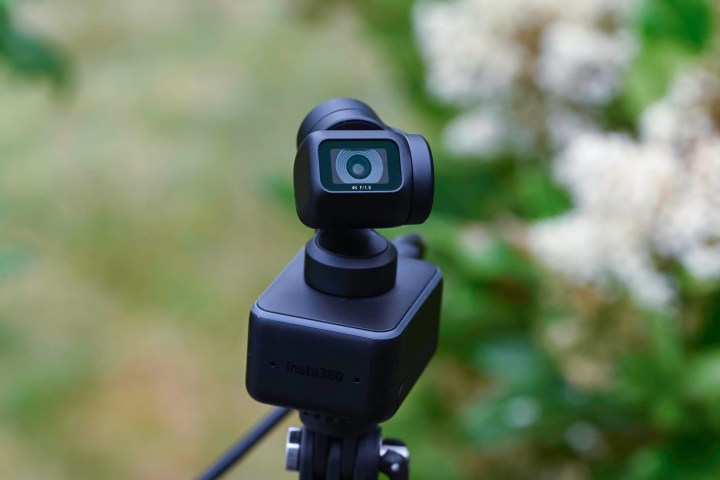
The Insta360 Link also features a handy desk view mode, an overhead view mode, and a portrait mode, all of which combine to further increase the versatility of the camera.
You’ll definitely want to install the Insta360 Link Controller software on your computer. This allows you to make fine adjustments to various settings, switch modes, update the firmware, adjust camera parameters, and control movement of the camera via an on-screen joystick.
The software can be used to record on its own, or as a taskbar overlaid on top of other streaming and recording applications. It’s very slickly designed and quite intuitive to use.
While I initially experienced stability issues due to pre-release firmware, by the time I finished testing the Link for this review, those issues had been ironed out.
The only other areas of concern that’s worth mentioning is the thermal issues. The camera has a tendency to become quite hot during use — and it doesn’t take long either. The Link heats up rather quickly, to the point where after ten or more minutes of constant filming the temperature becomes a little worrying.
However, it never got so hot that I was concerned from a safety standpoint, but it did get warm enough that it might be unhealthy for its electronic components. On the plus side, I didn’t notice that the performance of the Link was directly affected by the increased heat. When in standby mode, the Link feels mildly warm to the touch.
Audio quality
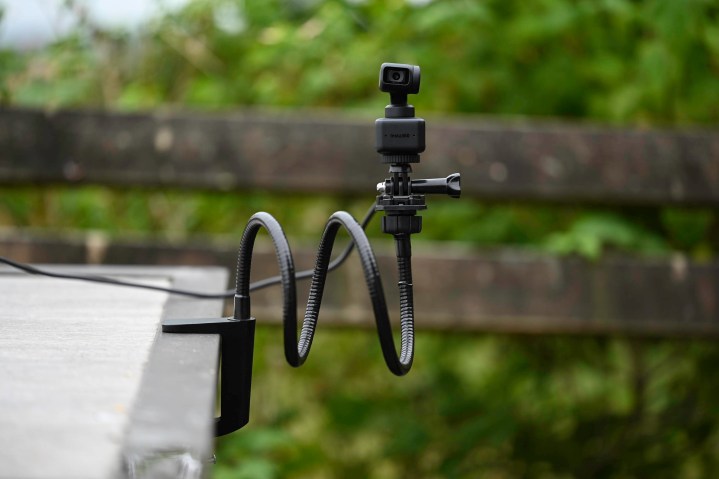
In terms of audio quality, the microphones built into the Link deliver decent voice capture capability. The noise canceling made it possible for me to record in outdoor environments with a lot of ambient noise, or next to a loud desktop gaming rig without having the whirring fans audible in the video.
The quality of the recording itself isn’t up there with a dedicated high-end mic, but I never expected it to. For what it is, I came away surprised at how good the quality was.
Price and availability
The Insta360 Link is available now for $300. While this is definitely a premium price point for a webcam, it feels reasonable for such an advanced device.
Our take
The Insta360 Link is the best webcam currently available, though those with less to spend and no need for a robot gimbal are better off with a more straightforward, cheaper webcam. For what it’s trying to be, the Link excels on almost every level, delivering a high level of convenience, while also rivaling bulky and expensive camera rigs in terms of quality.
There’s huge potential here for a wide range of applications and use cases — the options seem limitless. Who knew a webcam could be this interesting?
Is there a better alternative?
In terms of features and image quality, the Insta360 Link is practically unmatched. However, it’s also one of the more expensive webcams you can buy.
The Logitech Brio 4K is a popular option, offering that sharp 4K resolution for $100 less than the Insta360 Link.
The Obsbot Tiny is another camera-attached-to-gimbal concept. It also costs $100 less than the Insta360 Link, but only has a 1080p resolution.
How long will it last?
I’m fairly confident in the build quality of the Link, and I think it will last many years. The moving parts might perhaps inhibit potential longevity compared to a static webcam, but it’s hard to determine whether or not this difference in longevity would be meaningful if it even exists. I would expect to get at least five to 10 years out of the Link, given my experience with similar technology. For example, I’ve been using a drone with a comparable gimbal for five years, and it’s still going strong.
Should you buy it?
Yes. If you regularly use a webcam for education, business, livestreaming, or simple communication with friends and family, I highly recommend considering the Insta360 Link. Even if you’re not in the market for a webcam, the Link has significant value as an automated camera operator for a simpler way to record video content.





